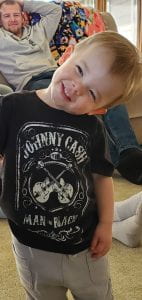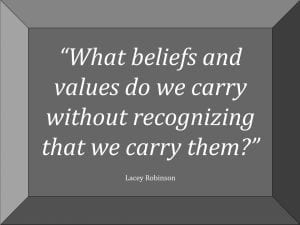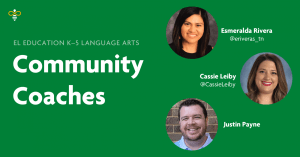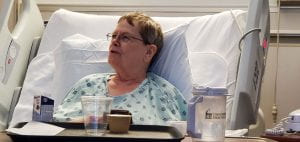The African proverb, “It takes a village to raise a child,” rings true each and every day. In fact, I would add, it takes a village to accomplish many, many tasks of worth.

Quincy Reed Richardson, my great nephew – from a very proud village!
There are times when a crazy thought crosses my mind: “Maybe I should teach preschool, kindergarten or first grade.” This is a crazy thought for me because I have only ever taught fourth, fifth, and sixth grade. I love those middle grades! I know that if that crazy thought ever becomes a real thing, I will need to work with a highly effective team, because it takes a village to truly pull off effective instruction.
If you had asked me five years ago if I’d be interested in teaching a primary grade, I would have responded with a resounding “No!” Five years later with some instructional coaching under my belt, I could entertain the idea (good thing because it’s not necessarily always my decision to make!). Among a zillion other things I have learned in this instructional coaching role, I have learned that good teaching is good teaching. What works with 5-years-olds is often the same that works with 18-year-olds, with some obvious tweaks. No matter the age level we work with, what works is this: collaboration with a powerful team. It takes a village.
One of the many benefits of being an instructional coach is that I get to be in preschool through 12th grade classrooms and watch all of the amazing-ness that happens. And it is truly amazing, at every grade level.
Which brings me back to my crazy thought. After watching preschool, kindergarten and first grade teachers, I think I could do it. Not nearly as well as them, but I could do it. I sometimes feel compelled to throw my hat in the preschool/kindergarten/1st grade arena because of all that happens in the world of building those foundational literacy skills. Those. Years. Are. Critical. I want to be able to apply what I’ve learned about effective literacy instruction in the last five years.
At the same time, I LOVE what I currently do, and I love the idea that my work could have a larger impact than on a single classroom. No matter what I do, I know this to be true: it takes a village. It just does. This work, this big work, cannot be done on a singular level. As I watch our most effective teacher teams, I watch the same thing over and over again: they do much more than collaborate. They set egos aside and make no excuses, they are laser-focused on results, and they adjust instruction with the use of intentional planning, flexible grouping, differentiation, and scaffolding. It takes a village.
What I am describing is professionalism in its truest sense of the word. In the words of Pamela Snow on Melissa & Lori Love Literacy, Episode, 145, “You know a lot about your students… but that doesn’t mean that you are necessarily bringing the strongest theoretical foundations to your work or the most recent evidence-based ways of thinking about teaching to your work… so… I think we’ve done a big disservice to teachers with “You’re the professional, you’re the expert, you decide’…” It takes a village to change this mindset, because it is deeply ingrained.
When we think (and I did for many, many years) that we are the expert and know the very best way to approach instruction because we have had success with certain methods, we are eliminating the possibility that there is evidence to suggest otherwise. This doesn’t fly in the medical profession, and it shouldn’t fly in the education profession. As Pamela Snow shared, “The hallmark of professionalism in many other disciplines is alignment with evidence based practice.” NOT with what we like, what makes our students “happy,” or what we have done for years.

The phenomenal Margaret Goldberg, co-founder of The Right to Read Project, said it best on Episode 145 of Melissa & Lori Love Literacy: “…now I look back and I’m like no matter how good I was, I was only as good as I could be for 180 days with my kids. And 180 days is too few to have a really good plan. You need to actually have a plan from K to 6 and know what kids are getting at what grade level and to know that every teacher is going to be able to deliver that for the students ’cause they have the tools to help them do it. The equally phenomenal Lacey Robinson of UnboundEd followed up with, “… And I think, Margaret, that you are really pressing on is the what and the why behind the development of reading and I think that the thing we have to keep reminding ourselves is that teachers, leaders, need a consistent, I would say an opportunity to keep fine-tuning their understanding of that.” It takes a village.

Back to what I had done for years: closed my door and did what I thought was best; I did what was comfortable and what I had had success with in the past. I was not relying on my village. I was trying to be the mayor of a town that was disconnected from everybody else. I did talk with my coworkers – I loved my coworkers! We even discussed things that had gone well and what we could do better, but we relied on the latest and greatest from online resources that were unvetted, rather than on a reliable curriculum aligned with evidence-based practice. We simply didn’t know any better.
There is nothing better than watching teacher teams who have it figured out, who know that it takes a village to get the job done. Our district uses the EL Education curriculum which has been a very heavy and very worthwhile lift. This lift has been made easier by the fabulous team of community coaches at Open Up Resources. Their bimonthly PLC’s offer tips, tricks, and advice from the field – they are living and breathing this curriculum in their classrooms every day, with much success. Thank you Cassie, Justin, and Esmeralda!!! It takes a village.

It Takes a Village, on a Personal Note
My amazing mom landed in the hospital this past weekend. 18 days of being back on cancer medicine tore up her insides, so we returned to an undesired routine of a visit to a local hospital resulting in a visit to University of Iowa Hospitals and Clinics. My siblings, my village, work together so that we can expedite the process for mom and make it as comfortable as possible, while checking in with Dad to make sure all is well with him. It takes a village.
The hospital staffs in both facilities have been top-notch. They work together to coordinate mom’s care, going above and beyond what is expected of them. They all take time to visit with Mom, listening attentively and chuckling at Mom’s stories. Sue Haeger is one of a kind, and she is part of the reason her care teams have been so amazing – they can’t help but love her positive spirit, sense of humor, and no-bones-about-it attitude. She always remarks on the superb care she receives from these medical teams. It takes a village.
